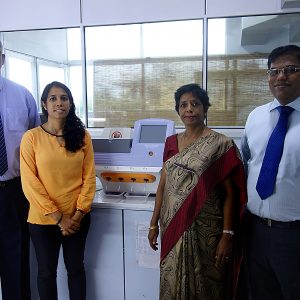The term veterinary science in a broad sense includes the disciplines of ‘animal health’ and ‘animal production’. [1] Many veterinary diseases are essentially of infectious nature, and they are of considerable economic importance. A large number of veterinary pathogens are found to cause infections in economically important as well as domestic animals in Sri Lanka. The global public health community has now recognized that the control of disease in animals is an important means to reduce human exposure to emerging infectious diseases, and has facilitated the development of veterinary public health capacities in Sri Lanka while continuing to extend knowledge through a regional network to researchers, governments and communities in South and Southeast Asia. [2]
In Sri Lanka certain diseases in cattle and buffaloes are classified notifiable. [3] Bacteria act as pathogens in cattle causing a variety of diseases. In many cases bacterial pathogens such as Brucella abortus, Trueperella pyogenes, Salmonella dublin, Bacillus licheniformis and Leptospira hardjo cause abortions in cattle. [4] Bacillus antraxis causes anthrax among herbivores, mainly in cattle and the disease is usually transmitted to humans upon inhalation, ingestion or contact of spores produced by the pathogen. [4] Mycobacteirum bovis is found responsible for tuberculosis in cattle, while Clostridium botulinum produces toxins that act as the source for botulism. [4] Bovine mastitis is another common disease among cattle and buffaloes and is caused by a variety of bacterial pathogens including Pseudomonas aeruginosa, Staphylococcus aureus, Staphylococcus epidermidis, Streptococcus agalactiae, Streptococcus uberis, Brucella melitensis, Corynebacterium bovis, E.coli, Klebsiella pneumoniae, Klebsiella oxytoca, Enterobacter aerogenes, Pasteurella spp., and Proteus spp. [5] Haemorrhagic septicemia is another acute disease among cattle and buffaloes caused by Pasteurella multocida, accounting for high mortality and morbidity levels. [3]
Poultry industry also faces the challenges of bacterial infections, due to frequent occurrence of pullorum disease or bacillary white diarrhoea among baby chicks. Pullorum disease is primarily transmitted via the hatching egg, and Salmonella pullorum acts as the source of the disease. Fowl typhoid is another septicaemic disease caused by Salmonella gallinarum and affects adult birds. [3]
Sri Lankan aquaculture production is often affected by bacterial infections due to poor health and disease monitoring programmes. The first bacterial disease outbreak reported during the period of 1988-1989 caused an average reduction of 64% in production and an estimated total loss of 186.62 Rs. million. [6] Luminescent vibriosis, caused by luminescent strains of Vibrio spp., has been recently recognized as the most serious disease affecting hatchery production of shrimps in northwestern coastal areas of Sri Lanka. Pseudomonas spp., were also seen in high frequencies in cultured shrimp samples from the same area. [7]
With such frequent occurrence rates of bacterial infections, veterinary discipline requires proper health and disease management programmes that facilitate accurate identification of pathogenic bacteria with highest possible accuracy and sensitivity. The Veterinary Research Institute is equipped for basic pathology, bacteriology and virology, including isolation and characterization of important pathogenic bacteria and viruses. Facilities are also available for serological work and radio immune assay techniques.The ELISA technique is popularly used for diagnosis of a wide range of diseases and in sero- epidemiological work. VRI also uses molecular techniques such as PCR, Poly Acrylamide gel electrophoresis (PAGE) and Pulse Field Gel Electorphoresis (PFGE). The entire array of techniques does have their own advantages, but carry certain constraints regarding accuracy, sensitivity, turn-around time and analysis capability. Conventional microbiological techniques such as plating requires a minimum turnaround time of 7-10 days while the identification is often impeded by fastidious microorganisms, unusual biochemical reactions, lack of previous knowledge or the presence of unculturable organisms. Low levels of sensitivity may lead to erroneous identification of pathogens. Since the techniques are highly dependent on operator expertise, the results may vary from laboratory to laboratory.
16s rRNA gene sequencing of bacteria is adopted in laboratories as a novel techniques in order to compensate the drawbacks of traditional techniques while minimizing the turnaround time and increasing the sensitivity levels. 16s rRNA gene sequencing facilitates identification of the total profile of known microorganisms in a single test only within 48 hours. Being a next generation sequencing based platform, it enables rapid throughput of data, with unmatched accuracy and sensitivity. With its ability to distinguish between the intragenic variations of closely related species as well as the relative abundances of species in a sample it allows further analysis of microorganisms for research purposes. Practically, 16s rRNA sequencing with its broad test spectrum, substitutes the entire array of conventional microbiological and biochemical tests, delivering faster, easier and accurate identification of microorganisms causing infectious diseases.
References-
- De Alwis, M. C. L. “Animal health research in Sri Lanka: A review of the past, future priorities and constraints.” Journal of the National Science Foundation of Sri Lanka3 (2012): 151-161.
- ca. 2013. Global Health Research Initiative – Home. [online] Available at: http://www.idrc.ca/EN/Programs/Global_Health_Policy/Global_Health_Research_Initiative [Accessed: 25 Nov 2013].
- Ravindran, V., N. Sriskandarajah, and R. Rajamahendran. “Diseases and parasites of domesticated animals in Sri Lanka.” Science Education Series: No. 29(2010).
- 2013. Defra. [online] Available at: http://www.defra.gov.uk [Accessed: 25 Nov 2013].
- Oikonomou, Georgios, et al. “Microbial diversity of bovine mastitic milk as described by pyrosequencing of metagenomic 16s rDNA.” PloS one10 (2012): e47671.
- Stevenson, N. J. “Disused shrimp ponds: Options for redevelopment of mangroves.” (1997): 425-435.
- Wijegoonawardena, P. K. M., and P. P. G. S. N. Siriwardena. “Shrimp farming in Sri Lanka: Health management and environmental considerations.” FAO Fisheries Technical Paper(1996).


